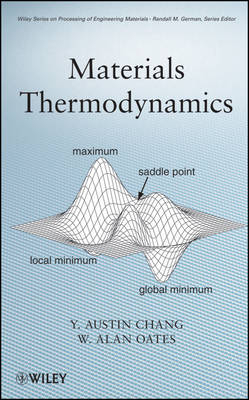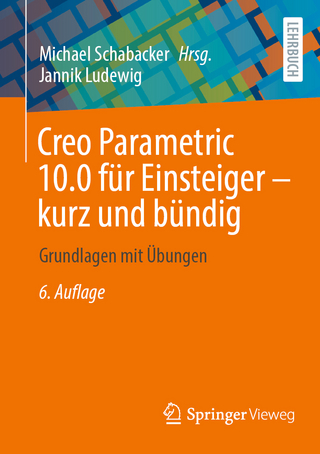
Materials Thermodynamics
John Wiley & Sons Inc (Verlag)
978-0-470-48414-2 (ISBN)
- Titel z.Zt. nicht lieferbar
- Versandkostenfrei innerhalb Deutschlands
- Auch auf Rechnung
- Verfügbarkeit in der Filiale vor Ort prüfen
- Artikel merken
A timely, applications-driven text in thermodynamics Materials Thermodynamics provides both students and professionals with the in-depth explanation they need to prepare for the real-world application of thermodynamic tools. Based upon an actual graduate course taught by the authors, this class-tested text covers the subject with a broader, more industry-oriented lens than can be found in any other resource available. This modern approach:
Reflects changes rapidly occurring in society at large—from the impact of computers on the teaching of thermodynamics in materials science and engineering university programs to the use of approximations of higher order than the usual Bragg-Williams in solution-phase modeling
Makes students aware of the practical problems in using thermodynamics
Emphasizes that the calculation of the position of phase and chemical equilibrium in complex systems, even when properly defined, is not easy
Relegates concepts like equilibrium constants, activity coefficients, free energy functions, and Gibbs-Duhem integrations to a relatively minor role
Includes problems and exercises, as well as a solutions manual
This authoritative text is designed for students and professionals in materials science and engineering, particularly those in physical metallurgy, metallic materials, alloy design and processing, corrosion, oxidation, coatings, and high-temperature alloys.
Y. Austin Chang is Wisconsin Distinguished Professor Emeritus in the Department of Materials Science and Engineering at the University of Wisconsin–Madison. He is a member of the National Academy of Engineering, Foreign Member of the Chinese Academy of Sciences, and the recipient of many honors and awards, including the J. Willard Gibbs Award, the Gold Medal, and A. E. White Distinguished Teacher Award of ASM International, and the W. Hume-Rothery Award, John Bardeen Award, and the Educator Award, all awarded by The Minerals, Metals and Materials Society (TMS). W. Alan Oates is a recipient of several awards, including the W. Hume-Rothery Award of TMS.¿Since 1992, Oates has held the position of Honorary Professor at the Science Research Institute, University of Salford, England.
Preface xiii
Quantities, Units, and Nomenclature xix
1 Review of Fundamentals 1
1.1 Systems, Surroundings, and Work 2
1.2 Thermodynamic Properties 4
1.3 The Laws of Thermodynamics 5
1.4 The Fundamental Equation 8
1.5 Other Thermodynamic Functions 9
1.5.1 Maxwell’s Equations 11
1.5.2 Defining Other Forms of Work 11
1.6 Equilibrium State 14
Exercises 15
2 Thermodynamics of Unary Systems 19
2.1 Standard State Properties 19
2.2 The Effect of Pressure 27
2.2.1 Gases 28
2.2.2 Condensed Phases 29
2.3 The Gibbs–Duhem Equation 30
2.4 Experimental Methods 31
Exercises 32
3 Calculation of Thermodynamic Properties of Unary Systems 35
3.1 Constant-Pressure/Constant-Volume Conversions 36
3.2 Excitations in Gases 37
3.2.1 Perfect Monatomic Gas 37
3.2.2 Molecular Gases 39
3.3 Excitations in Pure Solids 39
3.4 The Thermodynamic Properties of a Pure Solid 43
3.4.1 Inadequacies of the Model 46
Exercises 46
4 Phase Equilibria in Unary Systems 49
4.1 The Thermodynamic Condition for Phase Equilibrium 52
4.2 Phase Changes 54
4.2.1 The Slopes of Boundaries in Phase Diagrams 54
4.2.2 Gibbs Energy Changes for Phase Transformations 57
4.3 Stability and Critical Phenomena 59
4.4 Gibbs’s Phase Rule 61
Exercises 63
5 Thermodynamics of Binary Solutions I: Basic Theory and Application to Gas Mixtures 67
5.1 Expressing Composition 67
5.2 Total (Integral) and Partial Molar Quantities 68
5.2.1 Relations between Partial and Integral Quantities 70
5.2.2 Relation between Partial Quantities: the Gibbs–Duhem Equation 72
5.3 Application to Gas Mixtures 73
5.3.1 Partial Pressures 73
5.3.2 Chemical Potentials in Perfect Gas Mixtures 74
5.3.3 Real Gas Mixtures: Component Fugacities and Activities 75
Exercises 75
6 Thermodynamics of Binary Solutions II: Theory and Experimental Methods 79
6.1 Ideal Solutions 79
6.1.1 Real Solutions 82
6.1.2 Dilute Solution Reference States 83
6.2 Experimental Methods 85
6.2.1 Chemical Potential Measurements 86
Exercises 89
7 Thermodynamics of Binary Solutions III: Experimental Results and Their Analytical Representation 93
7.1 Some Experimental Results 93
7.1.1 Liquid Alloys 93
7.1.2 Solid Alloys 95
7.2 Analytical Representation of Results for Liquid or Solid Solutions 97
Exercises 102
8 Two-Phase Equilibrium I: Theory 103
8.1 Introduction 103
8.2 Criterion for Phase Equilibrium Between Two Specified Phases 104
8.2.1 Equilibrium between Two Solution Phases 104
8.2.2 Equilibrium between a Solution Phase and a Stoichiometric Compound Phase 107
8.3 Gibbs’s Phase Rule 108
Exercises 110
9 Two-Phase Equilibrium II: Example Calculations 113
Exercises 121
10 Binary Phase Diagrams: Temperature–Composition Diagrams 125
10.1 True Phase Diagrams 126
10.2 T –xi Phase Diagrams for Strictly Regular Solutions 128
10.2.1 Some General Observations 131
10.2.2 More on Miscibility Gaps 133
10.2.3 The Chemical Spinodal 134
10.3 Polymorphism 135
Exercises 136
11 Binary Phase Diagrams: Temperature–Chemical Potential Diagrams 139
11.1 Some General Points 140
Exercises 146
12 Phase Diagram Topology 149
12.1 Gibbs’s Phase Rule 151
12.2 Combinatorial Analysis 151
12.3 Schreinemaker’s Rules 153
12.4 The Gibbs–Konovalov Equations 154
12.4.1 Slopes of T –μi Phase Boundaries 155
12.4.2 Slopes of T –xi Phase Boundaries 157
12.4.3 Some Applications of Gibbs–Konovalov Equations 159
Exercises 162
13 Solution Phase Models I: Configurational Entropies 165
13.1 Substitutional Solutions 168
13.2 Intermediate Phases 169
13.3 Interstitial Solutions 172
Exercises 174
14 Solution Phase Models II: Configurational Energy 177
14.1 Pair Interaction Model 178
14.1.1 Ground-State Structures 179
14.1.2 Nearest Neighbor Model 180
14.2 Cluster Model 183
Exercises 188
15 Solution Models III: The Configurational Free Energy 189
15.1 Helmholtz Energy Minimization 190
15.2 Critical Temperature for Order/Disorder 193
Exercises 196
16 Solution Models IV: Total Gibbs Energy 197
16.1 Atomic Size Mismatch Contributions 199
16.2 Contributions from Thermal Excitations 202
16.2.1 Coupling between Configurational and Thermal Excitations 203
16.3 The Total Gibbs Energy in Empirical Model Calculations 204
Exercises 205
17 Chemical Equilibria I: Single Chemical Reaction Equations 207
17.1 Introduction 207
17.2 The Empirical Equilibrium Constant 207
17.3 The Standard Equilibrium Constant 208
17.3.1 Relation to Δr G◦ 208
17.3.2 Measurement of Δr G◦ 211
17.4 Calculating the Equilibrium Position 213
17.5 Application of the Phase Rule 217
Exercises 218
18 Chemical Equilibria II: Complex Gas Equilibria 221
18.1 The Importance of System Definition 221
18.2 Calculation of Chemical Equilibrium 224
18.2.1 Using the Extent of Reaction 225
18.2.2 Using Lagrangian Multipliers 227
18.3 Evaluation of Elemental Chemical Potentials in Complex Gas Mixtures 229
18.4 Application of the Phase Rule 231
Exercises 232
19 Chemical Equilibria Between Gaseous and Condensed Phases I 233
19.1 Graphical Presentation of Standard Thermochemical Data 233
19.2 Ellingham Diagrams 234
19.2.1 Chemical Potentials 238
Exercises 240
20 Chemical Equilibria Between Gaseous and Condensed Phases II 243
20.1 Subsidiary Scales on Ellingham Diagrams 244
20.2 System Definition 247
Exercises 252
21 Thermodynamics of Ternary Systems 255
21.1 Analytical Representation of Thermodynamic Properties 256
21.1.1 Substitutional Solution Phases 256
21.1.2 Sublattice Phases 259
21.2 Phase Equilibria 260
Exercises 264
22 Generalized Phase Diagrams for Ternary Systems 267
22.1 System Definition 276
Exercises 278
Appendix A Some Linearized Standard Gibbs Energies of Formation 279
Appendix B Some Useful Calculus 281
Index 289
| Erscheint lt. Verlag | 12.1.2010 |
|---|---|
| Reihe/Serie | Wiley Series on Processing of Engineering Materials |
| Verlagsort | New York |
| Sprache | englisch |
| Maße | 161 x 243 mm |
| Gewicht | 553 g |
| Themenwelt | Technik ► Maschinenbau |
| ISBN-10 | 0-470-48414-4 / 0470484144 |
| ISBN-13 | 978-0-470-48414-2 / 9780470484142 |
| Zustand | Neuware |
| Informationen gemäß Produktsicherheitsverordnung (GPSR) | |
| Haben Sie eine Frage zum Produkt? |
aus dem Bereich


